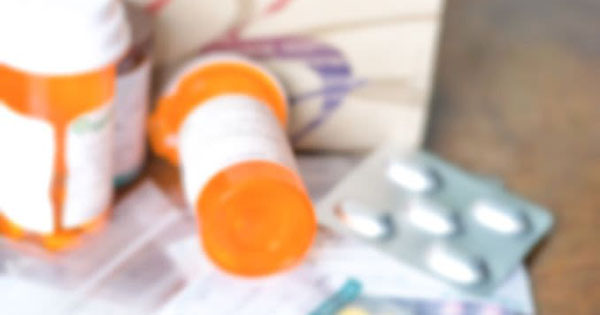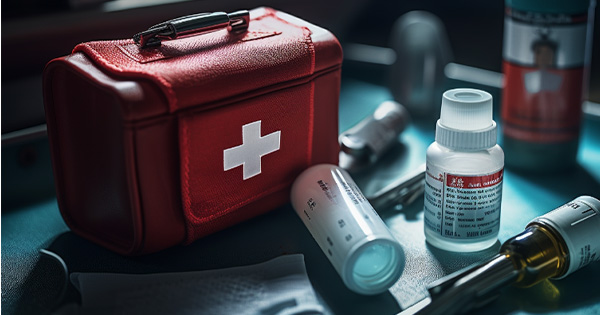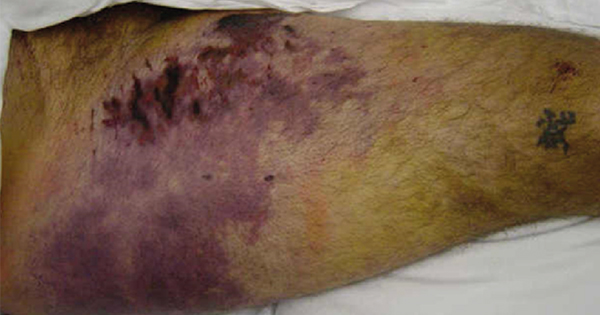This Ten Top Tips article will examine the frequently used medications in practice.
1 Normal saline
Normal saline is currently being used to cleanse wounds between dressing changes. Normal saline is an ideal solution for keeping wounds moist, but does not kill pathogens. Additionally, it cannot mechanically disrupt any biofilm development unless used at high pressure. Using a saline flush or endotracheal irrigation will not produce enough mechanical disturbance to the existing biofilm [Figure 1].
Normal saline can be used for cleansing minor cuts and burns in the acute phase, but once the wound has been open for more than three days, normal saline is not the recommended cleansing agent.
2 Dakin’s solution
Dakin’s solution, a diluted sodium hypochlorite (NaOCl), was discovered in 1787 by Henry Dakin, a chemist. It becomes activated when the solution reacts with water in the environment, forming sodium hypochlorite, which is a potent antibacterial agent. During World War II, the solution was used to provide continuous irrigation for battlefield injuries. Household bleach is essentially a concentrated version of Dakin’s solution (Ueno, 2018).
The most controversial aspect of Dakin’s solution is its toxicity to healing tissue. Dakin’s solution has a pH of 9-10, making it a highly alkaline solution.
While Dakin’s effectively kills bacteria, a laboratory study assessing its efficacy against Escherichia coli (E. coli), Pseudomonas aeruginosa, and Staphylococcus (Staph) aureus found that it killed E. coli in less than five minutes, Pseudomonas in 20 minutes, and Staph in less than 10 minutes (Wang, 2007). However, when used in high concentrations, Dakin’s solution can induce fibroblast toxicity, impairing wound healing (Keyes et al, 2023). It is also worth noting that full-strength Dakin’s is 0.5%, half-strength is 0.25%, and quarter-strength is 0.125%, which may cause confusion among some providers as half-strength might suggest 0.5% and quarter-strength might suggest 0.25%.
Furthermore, studies have suggested that concentrations greater than 0.025% may be harmful to wound healing (Cardile et al, 2014). Therefore, it is advisable to use Dakin’s solution to kill bacteria and visible bioburden, but it is not effective in the long-term management of wounds.
3 Hydrogen peroxide
Hydrogen peroxide has been used on wounds, including scrapes and cuts, for decades, if not centuries. It is known to possess antimicrobial properties against Gram positive and Gram negative bacteria, bacterial spores, fungi and viruses. However, hydrogen peroxide is highly detrimental to healing tissue, as its reactive power is not specific to microbes and pathogens but affects all tissues it encounters. It has also been used as a surgical scrub for certain dermatology procedures, but evidence suggests that routine use as a scrub is not recommended due to the known keratinocyte toxicity (Bednarek et al, 2023). It is time to retire the use of H2O2 from your wound care products.
4 Triple Antibiotic Ointment
Triple Antibiotic Ointment contains neomycin, polymyxin B and bacitracin. In this formulation, it is often used as a topical antibiotic for acute and chronic localised skin infections (Nguyen et al, 2022). The preference for topical antibiotic therapy over systemic antibiotics is evident, particularly for localised infections. Neomycin was named “Contact Allergen of the Year” for 2010 by the American Contact Dermatitis Society (Kreft and Wohlrab, 2022). The ease of availability of triple antibiotic ointment has contributed to the increase in allergic responses, as the response appears to worsen with repeated exposure and usage. Moreover, there exists a synergistic relationship between the allergy response of neomycin and bacitracin.
Additionally, in the context of antibiotic stewardship, the use of topical antibiotics when the wound is not infected or poses minimal risk of becoming infected is not recommended (Kreft and Wohlrab, 2022). For wounds that are closed and present minimal risk of infection, it is recommended to use petroleum jelly instead of topical antibiotic therapy (Draelos et al, 2011).
5 Honey
This one is a bit trickier than the others, as there are two different types of honey available. The best honey for wound care is medical-grade manuka honey, as it is sterile and has been formulated for safety and efficacy. On the other hand, over-the-counter honey from the grocery store has not undergone sterilisation and may contain trace amounts of botulism. Medical-grade honey has both antimicrobial properties and keeps the wound moist for a better healing environment (Samarghandian et al, 2017).
6 Topical Nitroglycerin
Nitroglycerin is a vasodilator used primarily in the treatment of angina, but it also has off-label uses for hypertensive crisis and coronary artery spasms (Kim et al, 2023). One study observed an improvement in pain and sleep after administering topical nitroglycerin below the knee of the affected limb (Jimenez and Whitney-Caglia, 2012). Nitroglycerin does promote vasodilation and may potentially aid in promoting wound healing, particularly in cases associated with vascular disease, although further studies are required to validate this. Another study (Hotkar et al, 2015) found that nitroglycerin improved wound healing and tissue protection from oxidative damage in diabetic foot ulcers. Again, more research will be necessary to determine if this treatment will be useful for other wounds.
We will now shift our focus to home remedies for wound care.
7 Epsom salt
Over years of doing wound care, it is fairly common to have a patient tell us that they soaked their wound in Epsom salt solution. Epsom salt, also known as magnesium sulphate, is a chemical compound made up of magnesium, sulphur and oxygen. It is named after Epsom, England, the town where it was first produced in the early 17th century by physician Dr Nehemiah Grew. The purported benefits of using Epsom salts include reduced pain and inflammation. However, there are associated risks with its use; soaking feet in hot water can lead to burns if neuropathy is present, and magnesium can dry the skin. Furthermore, if open wounds are present, bacteria from the wound may seep into the water and contaminate the rest of the foot.
8 Urine
The long-standing home remedy for snake bites, jellyfish stings and other toxins is to urinate on them. The theory behind this is that urine would neutralise the venom and make the pain go away. Instead, the opposite has been found. Urine can trigger the stinging cells to secrete more venom (Montgomery et al, 2016).
Reports indicate that vinegar, alcohol and baking soda slurry do not provide pain relief and can make the pain worse. Over-the-counter treatments such as corticosteroids and antihistamines can reduce pain and the release of venom from jellyfish barbs (Montgomery et al, 2016)
As for snake bites, the recommended first aid treatment includes cleaning the wound, applying a cool compress to reduce spreading, and promptly getting the person to an emergency department for treatment with antivenom and supportive care (Centers for Disease Control and Prevention, 2021).
9 Vinegar
Although, we have just disproved the use of vinegar in jellyfish and snakes, it does seem to have a place within wound care. A study published in 2017 found that 1% vinegar or acetic acid, was effective in killing a wide range of bacteria and fungi, as well as accelerating wound healing. (Agrawal et al, 2017).
However, there is another old wife’s tale about using vinegar for sunburns. Vinegar is a weak acid that can dry out the skin and potentially cause further irritation. The preferable treatment is to cool down the skin with a cool shower or rinse, and then apply a moisturiser to sun-exposed areas. Aloe vera and cucumbers have cooling properties and can also be used in the treatment of sunburn.
10
Vitamin E
In the authors’ experience, patients do not always disclose their regular intake of herbal supplements and other over-the-counter treatments, which can create polypharmacy and other unintended consequences. Vitamin E is a fat-soluble vitamin with antioxidant properties and, somewhere along the line, has been touted to prevent and treat scars (National Institute of Health Office of Dietary Supplements [NIH], 2021).
A literature review with six articles found that three of the six articles reported a significant improvement in the cosmetic appearance of scars, while the remaining three did not. Notably, two articles reported adverse effects such as contact dermatitis and increased itching and rash (Tanaydin et al, 2016).
Upon further investigation, the authors encountered conflicting advice regarding the use of vitamin E for scars, with some sources recommending its discontinuation while others advocating for its use. Based on our review, it remains uncertain whether vitamin E has a role in improving scar appearance. However, attention is drawn to its other action: antiplatelet aggregation.
Vitamin E indirectly increases the release of prostacyclin from the endothelium, which dilates blood vessels and inhibits platelet aggregation (NIH, 2021). Therefore, to have better outcomes, clinicians need to ask if patients are ingesting supplemental Vitamin E, as there is a higher bleeding risk.
Conclusion
Some of these wound “treatments” have been misused for decades, while others have gained attention more recently. Combating longstanding falsehoods requires a collective effort from all of us.



